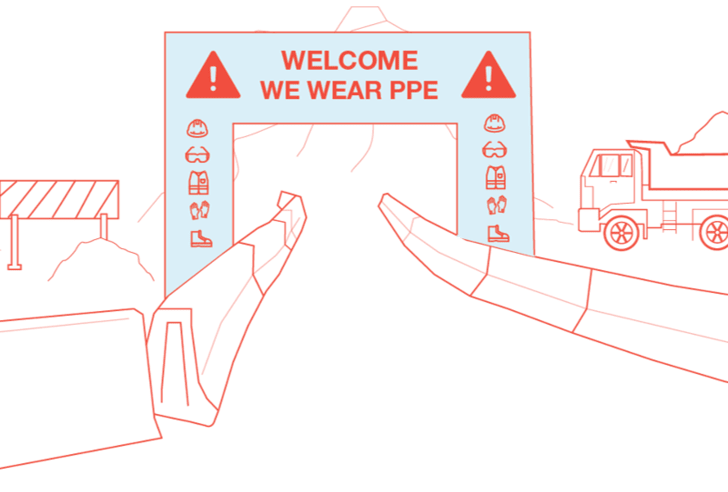A Nudge-led Approach To Hand Safety

By Superior Glove, leading safety glove innovator
Did you know that small changes in the environment can influence safer decisions and promote positive behavior? This theory is a concept in behavioral science that proposes subtle, indirect suggestions can effectively influence the behavior and decision-making processes of individuals and groups. By making slight tweaks to surroundings, we can create “nudges” that help workers make safer choices themselves. Unlike forceful interventions, nudges are subtle and maintain freedom of choice.
The science behind nudge theory
Our brains have two main systems that guide our decisions:
The thought-based system that’s slow and thorough and takes the time to plan and evaluate different paths before acting. This is the system that leads us to read safety manuals and think twice before handling hazardous materials.
The instinct-based system that’s all about quick reactions, gut feelings and immediate responses. It's the system that makes you instinctively pull your hand away from a hot surface, but it might also lead you to remove safety gloves because they’re uncomfortable This is where nudge theory comes into play. It allows us to tap into our instinct-based system, which usually drives around 90% to 95% of our daily decisions.
How nudge theory applies to hand safety
Now, you might be thinking, “How does this nudge theory work for hand safety?” By incorporating carefully crafted and well-placed nudges, you can influence workers to practice safer choices rather than bossing them around. Strategies such as visual direction, feedback, social proofing and timely delivery create a powerful nudge system that can enhance hand safety in the workplace.
Let’s take a closer look.
Visual direction
Often, the most effective method of communication isn't through written words – it’s through visual direction. Icons, symbols and other visual cues provide universal guidance, especially when language barriers exist. These visual nudges offer a sense of ease and direction, helping individuals make safer choices effortlessly. For example, an illustration of all necessary personal protective equipment needed for the tasks at hand at the entrance of a jobsite serves as a reminder for workers to wear the appropriate PPE.
Feedback
Feedback mechanisms play a crucial role in shaping behavior, especially in high-risk environments including in manufacturing and construction. Just like traffic lights guide our actions on the road, visual feedback cues – such as blinking lights or alarms – prompt individuals to adjust their behavior accordingly.
Social proofing
Social proofing is the influence that actions and behaviors have on each other. In a workplace setting, this could be seeing everyone wearing the same type of safety gloves, prompting others to follow suit. This social pressure can be used to promote safety norms and the proper use of PPE.
Timely information
Timing is crucial when it comes to decision-making. Supplying the right information at the right time can help support good decision-making. Imagine a worker about to operate a piece of machinery. A well-placed visual cue such as a safety sticker with an image of the particular glove that should be worn when operating the machine reminds them to put on their safety gloves.
Quick tips for implementing nudge theory in the workplace
Be a tourist in your own company: Record and document everything. Map out worker journeys and routines to identify potential hazards and areas for improvement.
Homemade signs: They can be valuable indicators of safety concerns. Pay attention to these informal cues and address them promptly.
Get outside perspective: Sometimes, it takes an outsider’s view to spot hidden dangers. Invite experts or consultants to evaluate your workplace and gain fresh insights.
Mind the reality gap: Be aware of the gap between safety policies on paper and actual practices on the ground. Bridge this reality gap by actively involving workers in safety initiatives and addressing their concerns.
Reward safe actions: Instead of focusing solely on injury rates, reward and recognize safe behaviors. Positive reinforcement encourages a culture of safety and motivates individuals to prioritize their well-being.
Be aware of your biases: Be mindful of cognitive biases such as overconfidence, confirmation bias and recency bias. These can cloud judgment and lead to overlooking potential risks.
Look and feel is important: Pay attention to the quality of your PPE. Emphasizing comfort and style can go a long way in positively influencing safety behavior.
Location, location, location: Ensure convenient access to PPE by strategically placing them in accessible locations.
Language and culture: Understanding the different cultures that make up your workforce is key to ensuring a safe workplace. Make sure training and materials are available in all languages spoken at your workplace and ensure safety signs can be understood without knowledge of English.
Don't reinvent the wheel: Learn from existing best practices and industry standards. Don't hesitate to adopt proven safety measures rather than starting from scratch.
Learn more
Don't stop your hand safety learning! Check out the most comprehensive guide on hand safety, “Rethinking Hand Safety,” to delve deeper into the world of nudge theory and its applications in workplace safety. The book also explores how the world’s safest companies have reduced injuries with more than PPE and practical and effective hand safety tips and tricks that you can use to improve your hand safety program. Click here.
Post a comment to this article
Safety+Health welcomes comments that promote respectful dialogue. Please stay on topic. Comments that contain personal attacks, profanity or abusive language – or those aggressively promoting products or services – will be removed. We reserve the right to determine which comments violate our comment policy. (Anonymous comments are welcome; merely skip the “name” field in the comment box. An email address is required but will not be included with your comment.)


